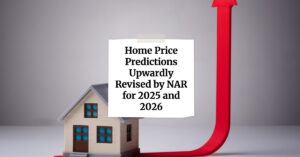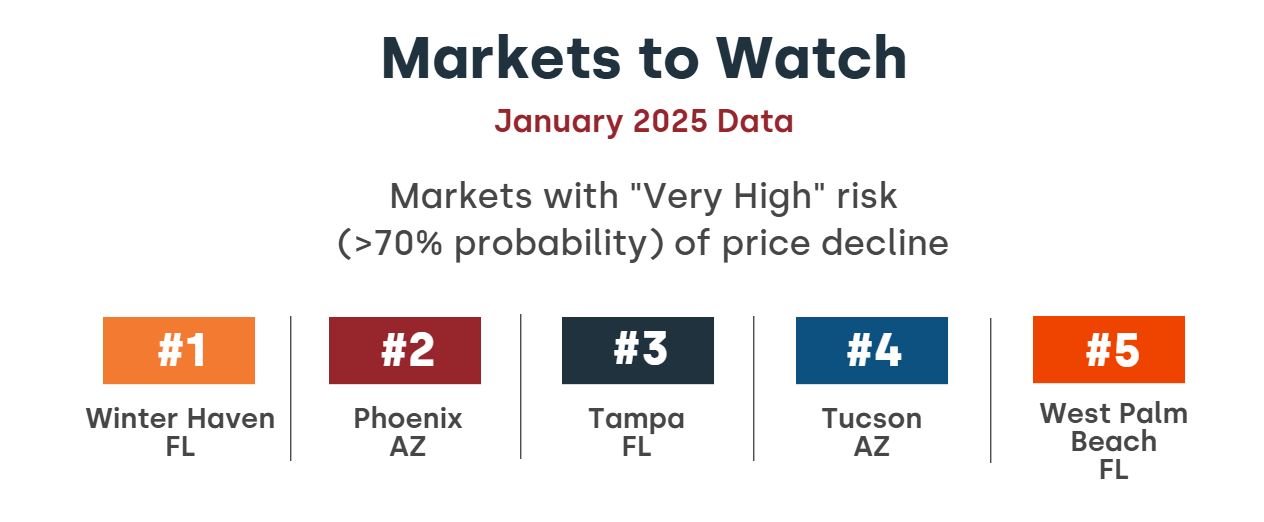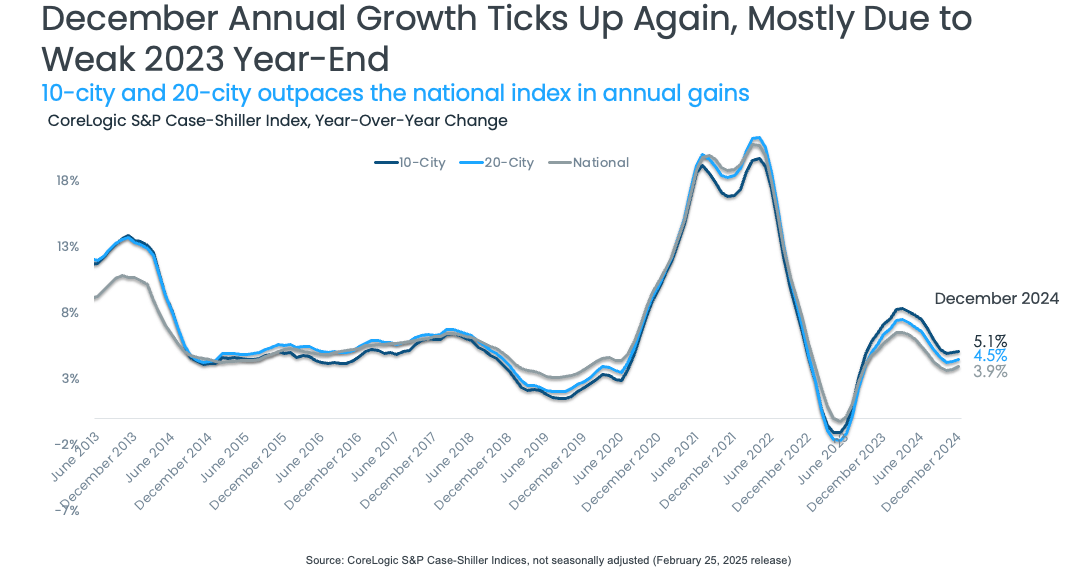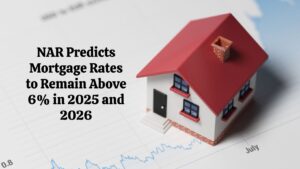Are you glued to housing market news, trying to figure out what's next? Are prices going up, down, sideways? Well, the latest word from the National Association of Realtors (NAR) is in, and it's a bit of a mixed bag, but with a clear upward nudge on prices. The home price forecast jumps for 2025 and 2026, according to NAR's revised projections, meaning we're likely to see home prices grow faster than initially expected in the coming years.
While they've slightly tempered expectations for home sales volume, the anticipated price increases are now more pronounced. Let’s break down what this means for everyone from first-time homebuyers to seasoned sellers.
Housing Price Forecast for 2025 and 2026 Increased by NAR
For months, I’ve been digging into market data, chatting with real estate pros in my area, and trying to make sense of all the conflicting signals. Initially, there was a lot of buzz about a potential boom in 2025. Now, that excitement is a little more grounded in reality. NAR's recent update gives us a clearer picture, even if it's not exactly what everyone was hoping for – especially those dreaming of drastically cheaper homes.
Key Takeaways: What You Need to Know
Here are the essential points to keep in mind about NAR's revised home price forecast jumps for 2025 and 2026:
- NAR has adjusted its housing market forecast downwards for 2025 in terms of sales volume, now projecting 4.3 million existing-home sales.
- However, they’ve increased their home price growth expectations for both 2025 (to 3%) and 2026 (to 4%).
- The primary reasons for these revisions are persistent affordability challenges and a more realistic outlook on market dynamics.
- Despite the tempered sales forecast, NAR and other experts remain cautiously optimistic about the overall housing market, citing a strong job market, potential for lower mortgage rates, and slowly improving inventory.
- The revised forecast is more in line with other industry predictions, suggesting a consensus view of moderate growth with continued price appreciation.
Now Expect Stronger Home Price Growth
Remember those earlier forecasts that hinted at a moderate 2% bump in home prices for both 2025 and 2026? Well, NAR has tweaked those numbers. In their latest Real Estate Forecast Summit Update, they’ve dialed up their home price growth projections to 3% for 2025 and a more significant 4% for 2026. This adjustment, while seemingly small on the surface, signals a notable shift in expectations.
What caused this change of heart, you might wonder? It boils down to a few key factors that are shaping today’s housing landscape.
Why the Forecast Shift? Affordability and Reality Check
If you've been house hunting recently, you already know the biggest hurdle: affordability. Even though we’ve seen some fluctuations in mortgage rates, they haven't dipped enough to truly make a significant dent in how much house the average person can afford. Prices have also remained quite sticky, not falling as much as some might have hoped.
- Stubbornly High Prices: Home prices haven’t plummeted. In many areas, they are still elevated compared to pre-pandemic levels. This baseline of higher prices means any percentage increase translates to a larger dollar amount.
- Mortgage Rate Reality: While we all keep wishing for those super-low rates of the past, the reality is that rates are likely to stay higher for longer than initially anticipated. This directly impacts buyer purchasing power.
- A Dose of Realism: I think NAR, like many of us who follow the market closely, is simply being realistic. The initial optimism for a massive housing boom in 2025 was perhaps a bit overzealous. The market is resilient, yes, but the factors needed for a truly explosive surge just aren't fully in place right now.
Essentially, the revised home price forecast jumps are a reflection of these persistent affordability challenges and a more tempered view of how quickly things will change. It’s not that the market is going to crash – far from it. It’s just that the pace of improvement, especially for buyers hoping for price relief, might be slower than previously thought.
Decoding the Revised Numbers: Sales and Prices in 2025 and 2026
Let's get into the specifics. Here’s a side-by-side look at NAR’s previous and revised forecasts, making it easy to see where the changes are:
| Forecast | Previous Estimate | Revised Estimate | Change |
|---|---|---|---|
| Existing Home Sales 2025 | 4.9 million | 4.3 million | -0.6 million |
| New Home Sales 2025 | Up 11% | Up 10% | -1% |
| Home Price Growth 2025 | 2% | 3% | +1% |
| Home Price Growth 2026 | 2% | 4% | +2% |
| Existing Home Sales 2026 | 10%-15% Up | Up 11% | Within Range |
| New Home Sales 2026 | Up 8% | Up 5% | -3% |
The table clearly shows the adjustments. While existing-home sales for 2025 are now expected to be lower than previously forecasted (4.3 million versus 4.9 million), the home price forecast jumps are the real story here. The anticipated price growth is now higher for both 2025 and 2026. This suggests that even with slightly fewer sales, demand and limited inventory are still likely to put upward pressure on prices.
Is It All Bad News? Reasons for Optimism Remain
Now, before you start feeling discouraged, especially if you're trying to buy a home, it's important to remember that this isn't a doomsday scenario. Despite the revised forecast, there are still plenty of reasons to be optimistic about the housing market's overall health.
As NAR Chief Economist Lawrence Yun pointed out, “The worst is over [for home sales]. The worst for inventory is over.” That’s a pretty strong statement coming from a leading expert. He also highlighted that the probability of a recession is still low, and key factors like job growth and the potential for lower mortgage rates are moving in a positive direction.
I echo this sentiment. From what I’m seeing and hearing, the market is showing resilience. Here’s why I believe there’s still room for optimism:
- Solid Job Market: A strong job market is the bedrock of a healthy housing market. People need to feel secure in their jobs to make big purchases like homes. The current job market, while having some shifts, is still generally robust.
- Mortgage Rates – Potential for Gradual Decline: While rates haven't plummeted, the consensus is that they are likely to drift downwards over time, even if slowly. Any decrease in rates will improve affordability and bring more buyers back into the market.
- Inventory – Slowly but Surely Improving: Inventory levels are still below historical norms in many areas, but they are starting to inch up in some markets. More homes on the market give buyers more choices and can help moderate price increases.
Recommended Read:
Warning of a Weak Housing Market: Are We Headed for Another Crisis?
Fannie Mae Lowers Housing Market Forecast and Projections for 2025
Housing Market Forecast 2025 by JP Morgan Research
Housing Predictions 2025 by Warren Buffett's Berkshire Hathaway
How Does NAR's Revised Forecast Stack Up?
It's always wise to look at different sources when making big decisions. Interestingly, NAR's revised forecast of 4.3 million existing-home sales for 2025 actually aligns more closely with predictions from other housing market experts.
Consider these figures:
- NAR (Revised): 4.3 million existing-home sales
- HousingWire (Mohtashami/Simonsen): 4.2 million existing-home sales
- Realtor.com: 4 million existing-home sales
This convergence of forecasts suggests that the revised NAR numbers aren't outliers but rather reflect a more widely held view of where the market is headed. It strengthens the credibility of the updated home price forecast jumps, as it’s not just one organization’s isolated opinion.
What does this mean for you?
- For Buyers: Focus on affordability above all else. Be patient but realistic. Don’t expect dramatic price drops. Budget carefully and be prepared for competition, especially for well-priced homes in desirable areas.
- For Sellers: The forecast suggests continued price appreciation, but don’t get overconfident. Price your home competitively based on current market conditions in your area. Work with a knowledgeable agent who understands local market nuances.
The housing market is always evolving, and staying informed is key. While the home price forecast jumps might not be thrilling news for buyers hoping for bargains, it does signal continued stability and moderate growth in the real estate sector. For both buyers and sellers, navigating this market successfully will require informed decisions and a realistic understanding of the current landscape.
Work with Norada in 2025, Your Trusted Source for Investment
in the Top Housing Markets of the U.S.
Discover high-quality, ready-to-rent properties designed to deliver consistent returns.
Contact us today to expand your real estate portfolio with confidence.
Contact our investment counselors (No Obligation):
(800) 611-3060
Also Read:
- Will the Housing Market Crash Due to Looming Recession in 2025?
- 4 States Facing the Major Housing Market Crash or Correction
- 5 Cities Where Home Prices Are Predicted To Crash in 2025
- New Tariffs Could Trigger Housing Market Slowdown in 2025
- Housing Market Forecast 2025: Affordability Crisis Will Continue
- Lower Mortgage Rates Will Reignite the Housing Demand in 2025
- NAR Predicts 6% Mortgage Rates in 2025 Will Boost Housing Market
- Housing Market Forecast for the Next 2 Years: 2024-2026
- Housing Market Predictions for the Next 4 Years: 2025 to 2028
- Housing Market Predictions for Next Year: Prices to Rise by 4.4%
- Housing Market Predictions for 2025 and 2026 by NAR Chief
- Real Estate Forecast Next 5 Years: Top 5 Predictions for Future
- Real Estate Forecast Next 10 Years: Will Prices Skyrocket?















